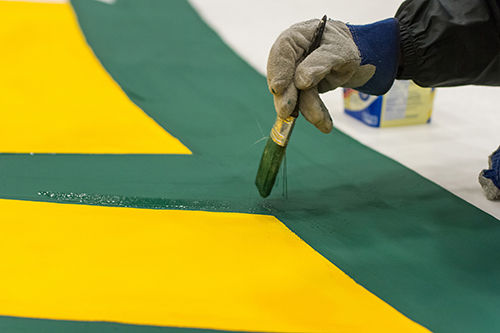Hazardous Materials
 Northern Michigan University has a hazardous materials management plan that complies with the Federal Hazard Communication Standards, as well as with Michigan's Right to Know Law. It covers acquisition, storage and transportation of hazardous materials, health assessment related to contact and exposure to hazardous materials and disposal of hazardous waste.
Northern Michigan University has a hazardous materials management plan that complies with the Federal Hazard Communication Standards, as well as with Michigan's Right to Know Law. It covers acquisition, storage and transportation of hazardous materials, health assessment related to contact and exposure to hazardous materials and disposal of hazardous waste.
All universities have some hazardous materials on campus, so educating the students, faculty and staff about proper hazardous materials procedures is an important element. NMU faculty and staff are required to participate in periodic training opportunities regarding this topic.
NMU's Safety Department oversees Northern's annual hazardous materials reports and coordinates semi-annual disposal of these materials.
See below for links to the semi-annual inventory and disposal forms, the full NMU Hazardous Materials Management Policy, as well as reporting sheets and links to other polices related to hazardous materials.
Asbestos
Since several buildings at Northern Michigan University were built when they still allowed Asbestos Containing Material (ACM) in building materials, asbestos management is an important program. Northern Michigan University's Asbestos Management Program is managed by the University's Safety Director. The Office of Facilities Management and the Purchasing Department play a major role in the program. In addition to the Management Plan, the University will maintain current procedures for management of ACM and presumed ACM (PACM). These procedures will be reviewed annually or more frequently if they amend applicable laws, by the University Safety Director and the Director of Facilities.
Mold
Molds can be found almost anywhere; they can grow on virtually any organic substance, as long as moisture and oxygen are present. When excessive moisture accumulates in buildings or on building materials, mold growth will often occur, particularly if the moisture problem remains undiscovered or unaddressed. It is impossible to eliminate all molds and mold spores in the indoor environment. However, mold growth can be controlled indoors by controlling the moisture levels. The Environmental Protection Agency (EPA) provides mold remediation guidance for proper clean-up of mold discovered within indoor facilities.
Responsibilities of University Employees
- Report stained or bowed ceiling tiles to your Supervisor or Facilities for an investigation of the water source.
- Report condensation seen forming on windows, walls, or pipes to your Supervisor for investigation and action.
- Report water infiltration around windows or exterior walls to your Supervisor and Facilities for investigation and repairs.
Responsibilities of the Safety Department
- Document the investigations of reported indoor mold and the clean-up response
- Provide training annually on mold basics and identification, prevention, and remediation.
- Provide annual PPE training.
- Conduct airborne mold spore monitoring if necessary.
- Contact mold remediation contractor as necessary.
Indoor Mold Prevention and Mediation Guidelines
Lead
Since several buildings at Northern Michigan University were built when they still allowed Lead in paint and other construction materials, lead management is an important program. Northern Michigan University's Lead Management Program is managed by the University's Safety Director. The Office of Facilities Management and the Purchasing Department play a major role in the program. In addition to the Management Plan, the University will maintain current procedures for management of Lead. Federal and state regulatory standards have helped to reduce the amount of lead in air, drinking water, soil, consumer products, food, and occupational settings. These procedures will be reviewed annually or more frequently if they amend applicable laws, by the University Safety Director and the Director of Facilities.
